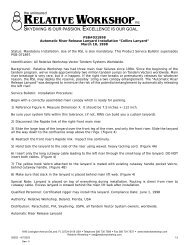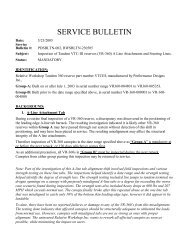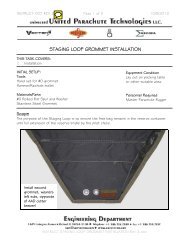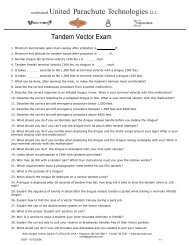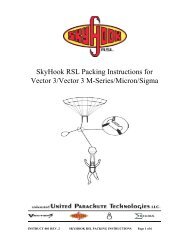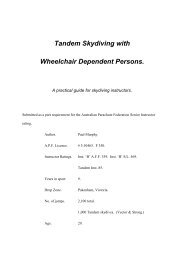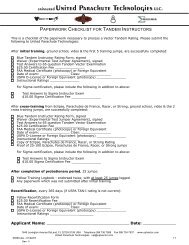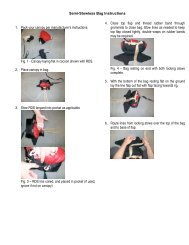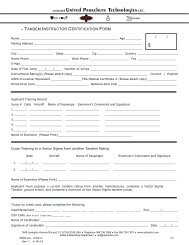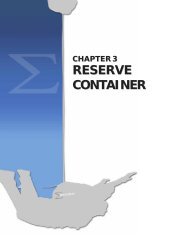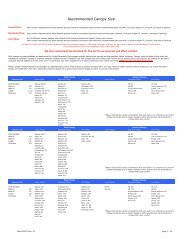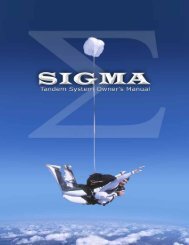DESCRIPTION DESCRIPTION - United Parachute Technologies
DESCRIPTION DESCRIPTION - United Parachute Technologies
DESCRIPTION DESCRIPTION - United Parachute Technologies
Create successful ePaper yourself
Turn your PDF publications into a flip-book with our unique Google optimized e-Paper software.
SIGMA TANDEM SYSTEM OWNER’S MANUAL<br />
The advantages of this system are obvious. The spherical shape of the ripcord handles, and their<br />
method of attachment, makes snagging highly unlikely. If dislodged, they automatically return to<br />
position, so no more searching for “floating” ripcords. And the unique “Safety Pin,” connected to<br />
the drogue bridle, makes it virtually impossible for a snagged ripcord handle to cause an accidental<br />
container opening. And let’s not forget, you no longer have to waste time and effort stowing the<br />
handles after opening, or searching for them at packing time.<br />
Because this system is new (The first production rigs went into service Summer 2000), we don’t yet know how long the<br />
recoil ripcord system will last under actual field conditions. Although bench tests show that the ripcord system can<br />
last for over 1,000 jumps, you should inspect the whole system often for signs of wear.<br />
Look for wear at the junction of the Spectra ripcords and the handles, and around the pin area. The Spectra is 1,000<br />
lbs. strong, and the force required to pull the pin is less than 10 lbs. That’s over a 100 to 1 safety margin, so a small<br />
amount of fraying should not be cause for alarm. Besides, the ripcord system is designed to be redundant. If one side<br />
were to break or jam for any reason, the other side is still fully functional.<br />
Also notice if the recoil system is doing its job properly. With the rig packed, each ripcord should snap back into place<br />
when pulled a few inches and released. But please realize, if you pull and release each ripcord handle several times<br />
before each jump, you will shorten the life of the system by a factor of three. Inspect, but don’t play with the system<br />
incessantly if you want maximum life from your ripcords.<br />
UNDERSTANDING THE SIGMA SKYHOOK RSL COLLINS’ LANYARD<br />
The Collins’ lanyard was designed to prevent a main-reserve entanglement, by releasing the left (non-RSL side) main<br />
riser, in the event that the right (RSL side) main riser breaks or prematurely releases by itself, for any reason. On the<br />
Sigma, it is integrated into the RSL with no external lanyard. This is accomplished by threading the left riser 3-ring<br />
release cable through a loop in the reserve static line (RSL). As the right riser leaves, the RSL automatically pulls the<br />
left cutaway cable as it pulls the reserve pin, yielding an almost simultanious breakaway and clean reserve deployment.<br />
A standard RSL does one thing. It pulls the reserve ripcord pin automatically after a breakaway. The Skyhook RSL does<br />
this, and then goes two steps further.<br />
A. It automatically releases the Left (non-RSL) riser, if the right (RSL) riser releases prematurely for any reason (Collins.<br />
Lanyard). (You wouldn.t want your reserve container opened with one riser still attached, would you?)<br />
B. It then uses your departing main canopy as a super .pilot chute. to get your reserve to line stretch faster<br />
than ever before. Breakaway, to canopy-out-of-bag times are between ½ and ¾ of a second, depending on the<br />
size of your reserve canopy. This is up to three times faster than a pilot chute can do it alone.<br />
If you have a main total malfunction, or your AAD fires, the Skyhook Lanyard automatically releases, and<br />
therefore does nothing to hinder normal reserve deployment.<br />
Page 12:X Section 2: Equipment • Chapter 1 - Description 11301 - 00.00.0000



